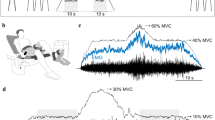Summary
The relation between the force exerted by the left arm and the electromyographic (EMG) activity of the brachial biceps and triceps muscles was examined during constant effort contractions maintained for 120 s. The initial force levels were set at 35%, 50% and 65% of each subject's maximal strength, but thereafter no feedback was provided. In contrast to previous results it was found that the direction of the change in force and EMG during constant effort contractions was dependent on the level of force initially exerted. During the lowest initial force contraction the force remained constant, while for the other two force levels there was an exponential decline in the force exerted. These changes in force during the three contractions were well described by an exponential equation with two free parameters. The EMG also varied as a function of initial force. For the higher two forces the amplitude of the EMG fluctuated during the first 40 s but thereafter remained constant, while it increased steadily during the lowest initial force contraction. These results suggest that depending upon the initial level of exertion either peripheral sensory cues relating to the actual force exerted, or centrally-generated signals reflecting the magnitude of the descending motor command may be used by subjects to maintain a constant level of muscular effort.
Similar content being viewed by others
References
Bonde-Petersen F, Mork AL, Nielsen E (1975) Local muscle blood flow and sustained contractions of human arm and back muscles. Eur J Appl Physiol 34: 43–50
Box GEP, Jenkins GM (1976) Time series analysis. Forecasting and control. Holden-Day, San Francisco
Burke D, Hagbarth KE, Lofstedt L, Wallin BG (1976) The responses of human muscle spindle endings to vibration during isometric contraction. J Physiol 261: 695–711
Cafarelli E, Bigland-Ritchie B (1979) Sensation of static force in muscles of different length. Exp Neurol 65: 511–525
Cain WS (1973) Nature of perceived effort and fatigue: roles of strength and blood flow in muscle contractions. J Mot Behav 5: 33–47
Cain WS (1977) Versatility of the constant-effort procedure. In: Borg G (ed) Physical work and effort. Pergamon Press, Oxford, pp 49–60
Cain WS, Stevens JC (1971) Effort in sustained and phasic handgrip contractions. Am J Psychol 84: 52–65
Cain WS, Stevens JC (1973) Constant-effort contractions related to the electromyogram. Med Sci Sports 5: 121–127
Campbell EJM, Edwards RHT, Hill DK, Jones DA, Sykes MK (1976) Perception of effort during partial curarization. J Physiol 263: 186P-187P
Crago PE, Houk JC, Rymer WZ (1982) Sampling of total muscle force by tendon organs. J Neurophysiol 47: 1069–1083
De Luca CJ (1979) Physiology and mathematics of myoelectric signals. IEEE Trans Biomed Eng 26: 313–325
Gandevia SC, McCloskey DI (1977a) Sensations of heaviness. Brain 100: 345–354
Gandevia SC, McCloskey DI (1977b) Changes in motor commands as shown by changes in perceived heaviness, during partial curarization and peripheral anaesthesia in man. J Physiol 272: 673–689
Jones LA, Hunter IW (1981) The relation of force and EMG to the perception of effort. Soc Neurosci Abstr 7: 477
Jones LA, Hunter IW (1983) Perceived force in fatiguing isometric contractions. Percept Psychophys (in press)
Jones LA, Hunter IW (1982) The role of centrally-generated motor commands and sensory signals in the perception of muscular force. Soc Neurosci Abstr 8: 732
Maton B (1981) Human motor unit activity during the onset of muscle fatigue in submaximal isometric isotonic contraction. Eur J Appl Physiol 46: 271–281
Matthews PBC (1982) Where does Sherrington's muscular sense originate? Muscles, joints, corollary discharges? Ann Rev Neurosci 5: 189–218
McCloskey DI (1978) Kinesthetic sensibility. Physiol Rev 58: 763–820
McCloskey DI (1981) Corollary discharges: motor commands and perception. In: Brooks VB (ed) Handbook of physiology. The nervous system. III. Motor control. Am Physiol Soc, Bethesda, pp 1415–1447
McCloskey DI, Ebeling P, Goodwin GM (1974) Estimation of weights and tensions and apparent involvement of a “sense of effort”. Exp Neurol 42: 220–232
Mitchell JH, Schibye B, Payne FC, Saltin B (1981) Response of arterial blood pressure to static exercise in relation to muscle mass, force development and electromyographic activity. Circ Res [Suppl] 1: 170–175
Pandolf KB, Cain WS (1974) Constant effort during static and dynamic muscular exercise. J Mot Behav 6: 101–110
Petrofsky JS (1980) Computer analysis of the surface EMG during isometric exercise. Comput Biol Med 10: 83–95
Rohmert W (1960) Ermittlung von Erholungspausen für statische Arbeit des Menschen. Int Z Angew Physiol 18: 123–164
Roland PE (1978) Sensory feedback to the cerebral cortex during voluntary movement in man. Behav Brain Sci 1: 129–171
Roland PE, Ladegaard-Pedersen H (1977) A quantitative analysis of sensations of tension and of kinaesthesia in man. Brain 100: 671–692
Shanno DF, Phua KH (1976) Minimization of unconstrained multivariate functions. ACM Trans Math Softw 2: 87–94
Stephens JA, Taylor A (1972) Fatigue of maintained voluntary muscle contraction in man. J Physiol 220: 1–18
Stevens JC, Cain WS (1970) Effort in isometric muscular contractions related to force level and duration. Percept Psychophys 8: 240–244
Author information
Authors and Affiliations
Additional information
IWH is a Canadian Muscular Dystrophy Association Post-doctoral Fellow
Rights and permissions
About this article
Cite this article
Jones, L.A., Hunter, I.W. Force and EMG correlates of constant effort contractions. Europ. J. Appl. Physiol. 51, 75–83 (1983). https://doi.org/10.1007/BF00952540
Accepted:
Issue Date:
DOI: https://doi.org/10.1007/BF00952540




